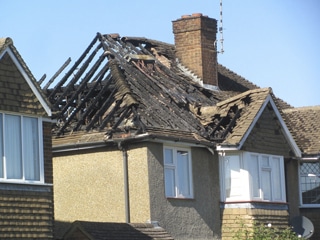Many people wonder when they should repair or replace their roofs. For example, a leaking roof should not be ignored. You should be concerned if pooling water can be found in your attic or on your walls. Water will discolor areas on your ceiling, usually ringed with brownish circles. If you see stains on your ceiling or wall surfaces, take a more detailed search for mold, dampness, and other indicators of leakage.
You should also be aware of any dripping or wet spots on the wall. Even if the leak seems to vanish, you should get it checked. You might have an ice dam brought on by the freezing and thawing of melting snow and ice during the winter season. This thawed water moves under the shingles and re-freezes, which triggers recurring leaks. If you see moisture, continue to investigate because issues can persist cause long-term damages.
Homeowners know that owning a home is a costly investment. For most people, their home is the most expensive thing they will ever own throughout the course of their life. While it may seem more affordable to temporarily repair the roof to fix a leak, it is not always the best option. Generally, repairs tend to cost proportionately more than replacements and create more risk than relief. But how do you know when a roof is bad enough to replace? There are two primary reasons for replacing a roof: damage and age.
Damage-related issues
Utah is known for its uniquely harsh weather, particularly when the seasons change. Weather conditions like wind, rain, snow, and extreme hot or cold temperatures can have an adverse effect on your roof. Weather can inflict “sudden damage” that is covered by many insurance policies. However, not all damaging weather is covered by insurance. Talk with a roofing professional to see if the damage on your roof is caused by a storm or considered “sudden damage.” If it is, they may be able to help you call in a claim and ultimately save you on the cost of a roof replacement. Here are a couple of weather conditions that can damage your roof:
1. Wind
Do you see shingles on the ground after a big windstorm? Wind can tear shingles and blow them off the roof. Your roof needs immediate attention if there are any missing shingles. If these shingles are not replaced immediately, it leaves your roof exposed to water damage and rot. When water leaks into your home, it will cause even more damage to your walls, insulation, and even the foundation. Strong winds can also lift the adhesive seal strip on your shingles. Without this, water can get underneath and cause the same type of water damage. Even small wind damage left unrepaired will lead to greater damage. Contact us as soon as possible so we can inspect the damage and promptly address the problem. Keep in mind that many insurance policies cover missing shingles due to wind storms.
2. Hail
If you have ever seen a severe hailstorm, you know the potential damage that hail has on our homes and possessions. The largest recorded hailstone was the size of a baseball — a whopping eight inches in circumference. Although most hail will not reach this outrageous size, these stones can still strike your roof with enough force to create indentations in the roof’s shingles and metal flashing. This will compromise the integrity of your roof and could lead to more damage. Hailstones are also a concern because they can remove the granular surface on your shingles and cause accelerated aging. Hail damage is covered by many insurance policies.
3. Fallen Trees
Fallen trees can inflict serious damage to a roof. If the impact creates a hole or opening, the damage can be an intrusive gateway to water damage. Fallen trees are a devastating threat not only to your roof but also to the overall condition and stability of your home. Many insurance policies consider this event “an act of God” or “sudden damage.”
4. Snow, sleet, or ice
Weight from a snowstorm that dumps six or more inches can be extremely stressful for a roof. Sleet or ice can cause significant water leaks or damage if they are not removed promptly. Water tends to find its way into small cracks and connections that are not properly sealed. This water then freezes and expands, turning a small problem into a larger one. Leaks will show themselves as the seasons change and winter turns to spring.
5. Rain
Downpours can wash away the granular surface on your roof’s shingles. If temperatures drop and the water freezes, the roofing materials can expand and crack. This type of water damage compromises the integrity of your roofing system and is likely to cause major mold growth and interior water leaking in years to come. Rainfall can erode your shingles over time and exacerbate other damage on the roof.
6. Heat
Shingles deflect harmful ultraviolet rays from the sun. Extreme temperatures dry out your shingles and cause them to lose their flexibility over time. Because they become brittle, your shingles are more likely to crack when dealing with snow and extreme temperatures. The most common circumstance that impacts the temperature of the roof is ventilation. Quality materials and installation can provide proper airflow to your attic, cooling your roof and dramatically increasing the life of your shingles. More than one layer of shingles will add unnecessary weight to your roof and limit attic ventilation.
Age-related issues
When a roof is being replaced because of its old age, wear-and-tear over time has usually compromised the integrity of the roof. Here are some age-related factors you should look for when determining if you should replace your roof:
1. Old age
How long has it been since your roof was installed? Were you the homeowner at the time? Do you know what products were used? Even though today’s shingles are designed to last longer, most roofing experts think the average lifespan of a roof is between 20 to 25 years. Therefore, if your roof is older than 25 years, your roof may be old enough to replace.
2. Curling shingles
Curling or buckling shingles can be a sign of heat damage over time due to high temperatures and improper ventilation. Curling shingles also might be an indicator of organic shingles that are no longer in production. Observe your roof where the sunlight hits or where snow tends to pile up the most to see the conditions of your shingles. If any of them are curled or broken, you should contact a professional.
3. Missing granules on shingles
As shingles age, they begin to lose their asphalt granules. These high-tech granules manufactured into the shingles protect your entire home. Cold temperatures can damage the granules and rain or snow can wash them off the roof and into the gutters. If you notice your gutters are clogged, you may want to check for these loose asphalt granules. Hot temperatures can cause a “heat blister” on your shingles, which looks like a tattered hole on your roof. You should contact a professional roof inspector to determine whether this damage is due to heat or storm damage, as this could affect your cost.
4. Neighbors replacing their roofs
Your home was probably built around the same time as your neighbors’ homes, so when you notice they are getting a roof upgrade, it’s probably time for you to inspect your own roof. Also, your neighbors experience the same weather conditions as you, therefore, the level of deterioration is more or less the same.
Rock Top has extensive experience performing roof inspections and assessing damage. We strive to help homeowners, buyers, real estate agents, property managers, and contractors protect their investments by providing an energy-efficient roof with quality craftsmanship and superior customer service. We have educated many people in Salt Lake City and surrounding areas in northern Utah about the importance of a quality roof. Contact Rock Top today at (801) 567-1234 for any questions or to schedule an inspection.

